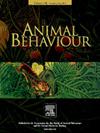Personality composition affects group cohesion of homing pigeons in response to novelty and predation threat
IF 2.3
2区 生物学
Q2 BEHAVIORAL SCIENCES
引用次数: 0
Abstract
Understanding how and why animal groups behave collectively is a central question in behavioural and social sciences. Variation in the phenotypic composition of the individuals within a group can lead to differences in group attributes and performance. However, whether and how individual personalities translate into group performance is not yet fully understood because experiments that test such hypotheses in realistic set-ups are still scarce. We explored how between-group variation in personality composition affected flock cohesion during homing flights of homing pigeons, Columba livia. Based on consistent individual differences, we established flocks of either ‘more reactive’ (MR flocks) or ‘less reactive’ (LR flocks) pigeons naïve to homing. Cohesion of flocks was tested in three distinct challenges: (1) first-ever collective homing experience (novelty); (2) release from a novel site (novel site homing); and (3) hunt by a robotic peregrine falcon (predation threat), with the latter two challenges performed with flocks trained for homing. MR flocks were more cohesive than LR flocks in the novelty challenge, but showed similar levels of cohesion during the novel site homing challenge. Predation threat decreased cohesion in both flock types, with a stronger effect in LR flocks. These results indicate that differences in the composition of personalities of group members can produce detectable differences in collective performance, and highlight the importance of accounting for individual-level behavioural variation when studying collective patterns in nature.
个性构成对信鸽群体凝聚力的影响主要表现在对新颖性和捕食威胁的反应上
理解动物群体如何以及为什么集体行为是行为科学和社会科学的一个核心问题。群体内个体表型组成的差异会导致群体属性和表现的差异。然而,个人性格是否以及如何转化为群体表现还没有被完全理解,因为在现实环境中测试这些假设的实验仍然很少。本研究探讨了信鸽(Columba livia)返航过程中,群体间人格组成差异对群体凝聚力的影响。基于一致的个体差异,我们建立了对归巢“反应更强”(MR群)或“反应更弱”(LR群)鸽子naïve群。在三个不同的挑战中测试了鸟群的凝聚力:(1)首次集体归巢体验(新颖性);(2)从新站点发布(新站点归巢);(3)由机器人游隼(捕食威胁)进行狩猎,后两项挑战是用训练有素的鸟群进行的。在新颖性挑战中,MR群的内聚性高于LR群,但在新颖性寻巢挑战中表现出相似的内聚性水平。捕食威胁降低了两种群体的凝聚力,其中LR群体的影响更大。这些结果表明,群体成员性格组成的差异可以在集体表现中产生可察觉的差异,并强调了在研究自然界中的集体模式时考虑个人层面行为差异的重要性。
本文章由计算机程序翻译,如有差异,请以英文原文为准。
求助全文
约1分钟内获得全文
求助全文
来源期刊

Animal Behaviour
生物-动物学
CiteScore
4.60
自引率
8.00%
发文量
236
审稿时长
10.2 weeks
期刊介绍:
Growing interest in behavioural biology and the international reputation of Animal Behaviour prompted an expansion to monthly publication in 1989. Animal Behaviour continues to be the journal of choice for biologists, ethologists, psychologists, physiologists, and veterinarians with an interest in the subject.
 求助内容:
求助内容: 应助结果提醒方式:
应助结果提醒方式:


